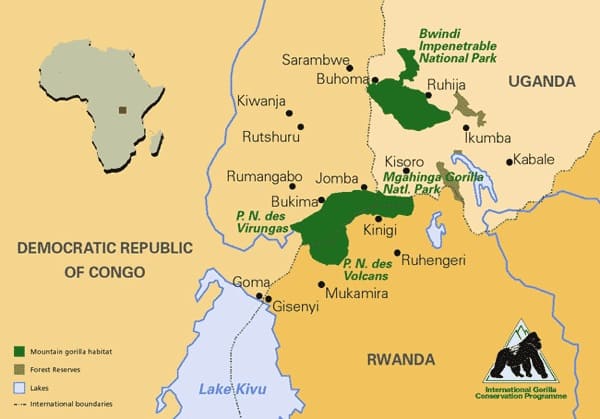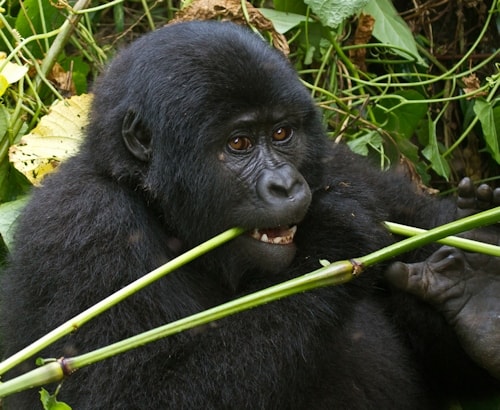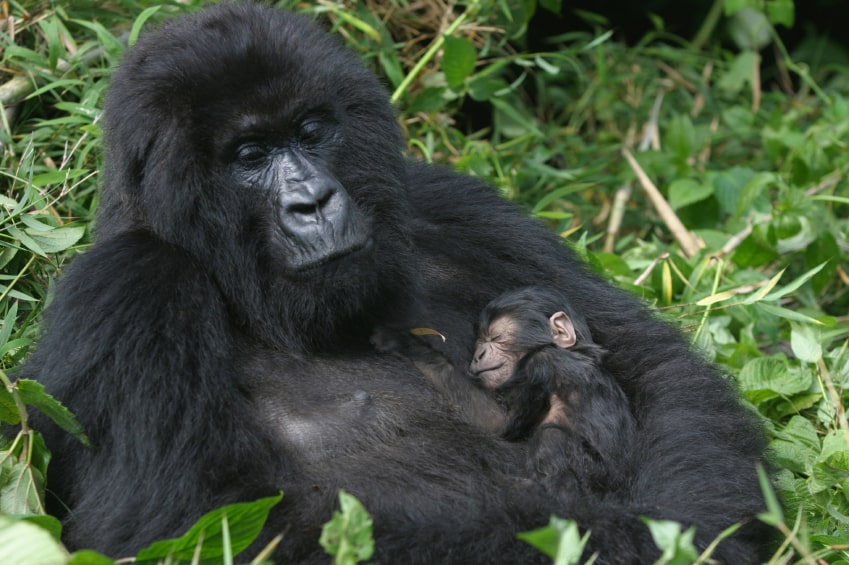Mountain Gorillas Prefer Forests on Mountains
Most mountain gorillas can be found in West and Central Africa. Although their name implies that they simply live on mountains, mountain gorillas actually prefer forested mountains. Most of these animals can be found living on green volcanic slopes, which is their preferred habitat. Apart from the Virungas Mountains, mountain gorillas can also be found in Uganda’s Bwindi Impenetrable National Park.
Mountain Gorillas Eat Roots and Bark
Mountain gorillas are herbivores, which means they consume a vegetarian diet. Mountain gorillas live in forests, which is where they find their food. Mountain gorilla troops feed on a variety of plant matter including roots, tree bark, pulp, plants, fruit, leaves, shoots and wild celery. Baby mountain gorillas rely on their mothers’ milk for sustenance. They are only fully weaned at approximately three and a half years old, when they will start eating the adult diet. Mountain gorillas don’t need water because they get sufficient moisture from the plants that they eat.
Mountain Gorillas Have a Distinctive Appearance
At first glance, all gorillas might appear to look the same. However, it is possible to tell the different species apart. Mountain gorillas tend to be a bit bigger than other species of gorillas. They also tend to have longer hair and shorter arms than other gorillas. This thicker fur acts as insulation, keeping them warm when the weather on the mountain gets cold. Male mountain gorillas have an additional crest of fur on their heads which is not evident in the females.
Mountain Gorilla Troops Have a Complex Hierarchy
Many of the most fascinating mountain gorilla facts relate to the structure of their troops. Mountain gorillas live in troops of up to 30 gorillas. The head of each troop is a dominant older adult male. The alpha male is usually at least 12 years old. This male leader is often called a silverback because of the patch of silvery gray fur on his back. Apart from this male, a troop will also consist of young males, some female gorillas, and their young.
Mountain Gorillas Are Active Creatures
The male leader of each troop will organize the activities for that group of gorillas. Although mountain gorillas can climb trees, they are usually found on the ground. Their activities include eating, nesting in leaves, and moving around their home range.
Mountain Gorillas Are Only Aggressive if Challenged
Mountain gorillas are usually calm and don’t display aggressive behavior. However, this all changes if a mountain gorilla, especially the alpha male, is disturbed or challenged. The fact that these animals have immense physical power is one of the mountain gorilla facts that indicate you should treat them with caution. If threatened, the male leader will roar, bark or hoot very loudly. He will also stand upright, pound his chest, throw things, and even make aggressive charges. A female mountain gorilla will fight to the death to protect her offspring.
Baby Mountain Gorillas Are Vulnerable
Although adult mountain gorillas possess incredible physical strength, the same cannot be said of the youngsters. Like humans, female gorillas have a nine-month pregnancy and tend to give birth to one baby. From the age of 10, female gorillas can produce offspring. Newborn mountain gorillas are tiny: they only weigh approximately four pounds (two kilograms). These babies are only able to cling to their mother’s fur. From the age of four months, they will ride on their mothers’ backs and will continue to travel like this for the next two or three years. A female gorilla will usually produce two to six offspring in her lifetime.
Young Mountain Gorillas Resemble Human Children
One of the more surprising mountain gorilla facts is that young mountain gorillas are said to resemble human children. Researchers and other human observers regularly note the similarities in behavior between human children and mountain gorillas when they are three to six years old. These young mountain gorillas like to spend their days playing together, as do children. They are often seen climbing trees, swinging from branch to branch, and chasing each other. The forest is their playground!
Mountain Gorillas Build New Nests Daily
One of the lesser known mountain gorilla facts is that the gorillas will build a new nest every day. This is because mountain gorillas are nomadic: they constantly move around their home range. Every evening the troop will be in a different place, and the gorillas have to construct new nests for the night. Mountain gorillas make their nests from readily available materials such as grasses and bent branches.
Mountain Gorillas Fall Victim to Human Political Violence
Around half the mountain gorilla population lives in Central Africa. They live in the forests of the Virunga Mountains. The green volcanic slopes that the mountain gorillas prefer are found in Uganda, Rwanda and the Democratic Republic of Congo. One of the most disheartening mountain gorilla facts is that these countries have experienced extensive political violence, which has negatively affected the mountain gorilla population.
Mountain Gorillas are Very Intelligent
Researchers have discovered many intriguing mountain gorilla facts. One of these facts is that gorillas are known to display significant intelligence. This is particularly noticeable in gorillas that have been kept in captivity. Some of the gorillas have even learned to communicate with people using simple human sign language!
Mountain Gorillas Are Endangered
With a worldwide population of around just 880, mountain gorillas are endangered. They constantly face threats relating to habitat loss, civil war and poaching. Baby gorillas are also illegally traded as research subjects, pets, and animals for private zoos. Fortunately, there are several conservation efforts that are aimed at trying to protect mountain gorillas. Recent research shows that their numbers are steady, and might even be on the increase.
Mountain Gorilla Facts – Facts about Mountain Gorillas Summary

Mountain Gorilla Facts



No comments:
Post a Comment